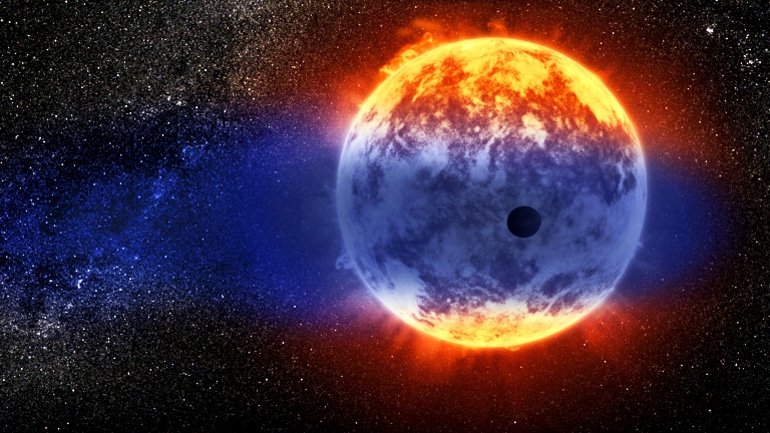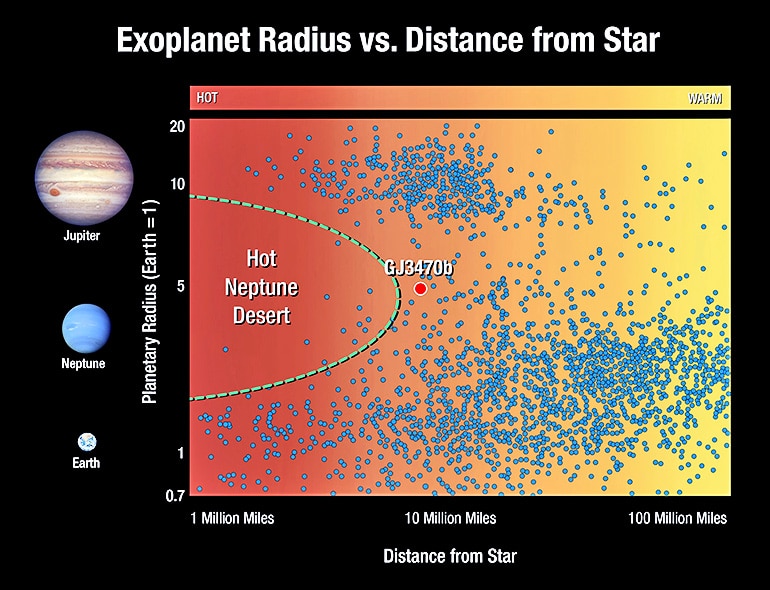An exoplanet almost 100 light years away from Earth is disappearing, and—by cosmic standards—disappearing fast, astronomers report.
Scientists using the Hubble Space Telescope discovered GJ 3470b—a medium-sized exoplanet roughly the size of Neptune is evaporating at a rate 100 times faster than a previously discovered planet of similar size.
“This is the smoking gun that planets can lose a significant fraction of their entire mass,” says David Sing, professor of astrophysics at Johns Hopkins University and an author of the study.

“GJ 3470b is losing more of its mass than any other planet we have seen so far; in only a few billion years from now, half of the planet may be gone.”
The findings, which appear in Astronomy & Astrophysics, advance knowledge about how planets evolve.
Hard to watch
The study is part of the Panchromatic Comparative Exoplanet Treasury program, which Sing leads, which aims to measure the atmospheres of 20 exoplanets in ultraviolet, optical, and infrared light as they orbit their stars. PanCET is the largest exoplanet observation program run with NASA’s Hubble telescope.
One particular issue of interest to astronomers is how planets lose their mass through evaporation. Planets such as “super” Earths and “hot” Jupiters orbit closer to their stars and are therefore hotter, which causes evaporation to blow away the outermost layer of their atmospheres.

While these larger Jupiter-sized and smaller Earth-sized exoplanets are plentiful, medium Neptune-sized exoplanets (roughly four times larger than Earth) are rare. Researchers hypothesize that the atmospheres of these Neptunes get stripped off and they ultimately turn into smaller planets.
It’s difficult, however, to actively witness them doing so, because researchers can only study them in UV light, which limits researchers to examining nearby stars no more than 150 light-years away from Earth, not obscured by interstellar material.
Nothing but a rocky core
GJ 3470b is 96 light-years away and circles a red dwarf star in the general direction of the constellation Cancer.
Hubble found that exoplanet GJ 3470b had lost significantly more mass and had a noticeably smaller exosphere than the first Neptune-sized exoplanet studied, GJ 436b, due to its lower density and receipt of a stronger radiation blast from its host star.
GJ 3470b’s lower density makes it unable to gravitationally hang on to the heated atmosphere, and while the star hosting GJ 436b was between 4 billion and 8 billion years old, the star hosting GJ 3470b is only 2 billion years old. A younger star is more active and powerful, and, therefore, has more radiation to heat the planet’s atmosphere.
Sing’s team estimates that GJ 3470b may have already lost up to 35 percent of its total mass and, in a few billion years, all of its gas may be stripped off, leaving behind only a rocky core.
“We’re starting to better understand how planets are shaped and what properties influence their overall makeup,” Sing says. “Our goal with this study and the overarching PanCET program is to take a broad look at these planets’ atmospheres to determine how each planet is affected by its own environment. By comparing different planets, we can start piecing together the larger picture in how they evolve.”
Sing and the team hope to study more exoplanets by searching for helium in infrared light, which will allow a greater search range than searching for hydrogen in UV light.
Currently, the only way to study planets made largely of hydrogen and helium is through tracing hydrogen in UV light. Using Hubble, the upcoming NASA James Webb Space Telescope (which will have a greater sensitivity to helium), and a new instrument called Carmenes that Sing recently found can precisely track the trajectory of helium atoms, astronomers will be able to broaden their pursuit of distant planets.
Source: Johns Hopkins University


